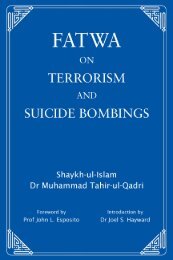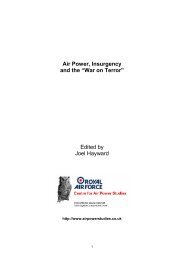Air Power, Insurgency and the âWar on Terrorâ - Prof. Joel Hayward's ...
Air Power, Insurgency and the âWar on Terrorâ - Prof. Joel Hayward's ...
Air Power, Insurgency and the âWar on Terrorâ - Prof. Joel Hayward's ...
Create successful ePaper yourself
Turn your PDF publications into a flip-book with our unique Google optimized e-Paper software.
Chapter 13<br />
ground, often termed “targets of opportunity”. Compared to pre-planned missi<strong>on</strong>s, it is<br />
not possible to exercise <str<strong>on</strong>g>the</str<strong>on</strong>g> same depth of judgment <strong>on</strong> <str<strong>on</strong>g>the</str<strong>on</strong>g> risks of collateral damage<br />
<str<strong>on</strong>g>and</str<strong>on</strong>g> civilian casualties. Both <str<strong>on</strong>g>the</str<strong>on</strong>g> pilots <str<strong>on</strong>g>and</str<strong>on</strong>g> <str<strong>on</strong>g>the</str<strong>on</strong>g> pers<strong>on</strong>nel <strong>on</strong> <str<strong>on</strong>g>the</str<strong>on</strong>g> ground make <str<strong>on</strong>g>the</str<strong>on</strong>g>ir own<br />
assessments, but naturally not as thoroughly as in pre-planned missi<strong>on</strong>s. In order to<br />
c<strong>on</strong>sider <str<strong>on</strong>g>the</str<strong>on</strong>g> target’s legitimacy, time can be <strong>on</strong>e of <str<strong>on</strong>g>the</str<strong>on</strong>g> aspects that influences <str<strong>on</strong>g>the</str<strong>on</strong>g> ethical<br />
assessment when attacking a target of opportunity. Even if a target is authorised by a<br />
higher comm<str<strong>on</strong>g>and</str<strong>on</strong>g> echel<strong>on</strong> <str<strong>on</strong>g>and</str<strong>on</strong>g> is in c<strong>on</strong>formity with relevant rules of engagement (ROE)<br />
<str<strong>on</strong>g>the</str<strong>on</strong>g> time factor is of importance. 538 But time al<strong>on</strong>e cannot account for <str<strong>on</strong>g>the</str<strong>on</strong>g> risk of making<br />
wr<strong>on</strong>g ethical judgments. Within this limited span, decisi<strong>on</strong>s with both operati<strong>on</strong>al<br />
<str<strong>on</strong>g>and</str<strong>on</strong>g> ethical implicati<strong>on</strong>s have to been taken fairly quickly. The judgment of pilots <str<strong>on</strong>g>and</str<strong>on</strong>g><br />
pers<strong>on</strong>nel <strong>on</strong> <str<strong>on</strong>g>the</str<strong>on</strong>g> ground is fur<str<strong>on</strong>g>the</str<strong>on</strong>g>r influenced by <str<strong>on</strong>g>the</str<strong>on</strong>g> “heat of <str<strong>on</strong>g>the</str<strong>on</strong>g> battle” <str<strong>on</strong>g>and</str<strong>on</strong>g> <str<strong>on</strong>g>the</str<strong>on</strong>g> time<br />
pressure imposed by <str<strong>on</strong>g>the</str<strong>on</strong>g> desire to c<strong>on</strong>duct <str<strong>on</strong>g>the</str<strong>on</strong>g> bombing. As Thomas Wards puts it: “How<br />
for example, can a belligerent know whe<str<strong>on</strong>g>the</str<strong>on</strong>g>r a bombing missi<strong>on</strong> promises sufficiently<br />
significant military gains to justify <str<strong>on</strong>g>the</str<strong>on</strong>g> risk of civilian casualties if both <str<strong>on</strong>g>the</str<strong>on</strong>g> risk of casualties<br />
<str<strong>on</strong>g>and</str<strong>on</strong>g> <str<strong>on</strong>g>the</str<strong>on</strong>g> prospective gains are matters of c<strong>on</strong>jecture?”. 539 The questi<strong>on</strong> is: does <str<strong>on</strong>g>the</str<strong>on</strong>g> pilot or<br />
<str<strong>on</strong>g>the</str<strong>on</strong>g> pers<strong>on</strong>nel <strong>on</strong> <str<strong>on</strong>g>the</str<strong>on</strong>g> ground have a complete picture of <str<strong>on</strong>g>the</str<strong>on</strong>g> situati<strong>on</strong>, so that he or she<br />
can decide if <str<strong>on</strong>g>the</str<strong>on</strong>g> risk of collateral damage, for example, is proporti<strong>on</strong>ate to <str<strong>on</strong>g>the</str<strong>on</strong>g> possible<br />
benefit? C<strong>on</strong>straints from <str<strong>on</strong>g>the</str<strong>on</strong>g> envir<strong>on</strong>ment can add to <str<strong>on</strong>g>the</str<strong>on</strong>g> difficulty of forming sound<br />
judgments. Yet making an ethically correct judgement is up to <str<strong>on</strong>g>the</str<strong>on</strong>g> individuals c<strong>on</strong>cerned.<br />
Ethics must be <strong>on</strong>e of <str<strong>on</strong>g>the</str<strong>on</strong>g> crucial assessments when bombs are to be dropped.<br />
Ordnance<br />
When engaging a target of opportunity, <str<strong>on</strong>g>the</str<strong>on</strong>g> aircraft has <strong>on</strong>ly its loaded ordnance. There is<br />
little flexibility c<strong>on</strong>cerning what kind of ordnance to use <strong>on</strong>ce <str<strong>on</strong>g>the</str<strong>on</strong>g> aircraft is airborne. Thus,<br />
air power can be less flexible when it comes to delivering relevant ordnance which can<br />
be adjusted to changes in <str<strong>on</strong>g>the</str<strong>on</strong>g> tactical situati<strong>on</strong>. The ordnance selected for a pre-planned<br />
missi<strong>on</strong> is specially picked out for <str<strong>on</strong>g>the</str<strong>on</strong>g> designated target <str<strong>on</strong>g>and</str<strong>on</strong>g> can <str<strong>on</strong>g>the</str<strong>on</strong>g>refore be subject to<br />
an assessment of proporti<strong>on</strong>ality. This can not be d<strong>on</strong>e to <str<strong>on</strong>g>the</str<strong>on</strong>g> same degree when targets<br />
of opportunity are to be attacked. It seems that air power fights with ordnance designed<br />
for c<strong>on</strong>venti<strong>on</strong>al war. The tool <strong>on</strong>e already has decides what <strong>on</strong>e does. 540 In today’s battle<br />
envir<strong>on</strong>ment that ordnance is ill-suited to some of <str<strong>on</strong>g>the</str<strong>on</strong>g> missi<strong>on</strong>s c<strong>on</strong>ducted. So both <str<strong>on</strong>g>the</str<strong>on</strong>g><br />
lack of flexibility c<strong>on</strong>cerning ordnance <strong>on</strong>ce airborne <str<strong>on</strong>g>and</str<strong>on</strong>g> ordnance not adjusted to targets<br />
create ethical challenges. The principle of proporti<strong>on</strong>ality emphasises <str<strong>on</strong>g>the</str<strong>on</strong>g> important moral<br />
aspect of minimizing <str<strong>on</strong>g>the</str<strong>on</strong>g> harm inflicted. Is it ethically right to use a 500 pound GBU 541<br />
against two insurgents?<br />
Intelligence<br />
Precisi<strong>on</strong> guided muniti<strong>on</strong>s can <strong>on</strong>ly be as precise as <str<strong>on</strong>g>the</str<strong>on</strong>g> intelligence <str<strong>on</strong>g>the</str<strong>on</strong>g> bombing is<br />
based up<strong>on</strong>. In <str<strong>on</strong>g>the</str<strong>on</strong>g> words of Phillip Meilinger: “In essence, <str<strong>on</strong>g>Air</str<strong>on</strong>g> <str<strong>on</strong>g>Power</str<strong>on</strong>g> is targeting, targeting<br />
<str<strong>on</strong>g>Air</str<strong>on</strong>g> <str<strong>on</strong>g>Power</str<strong>on</strong>g>, <str<strong>on</strong>g>Insurgency</str<strong>on</strong>g> <str<strong>on</strong>g>and</str<strong>on</strong>g> <str<strong>on</strong>g>the</str<strong>on</strong>g> “War <strong>on</strong> Terror” 229





